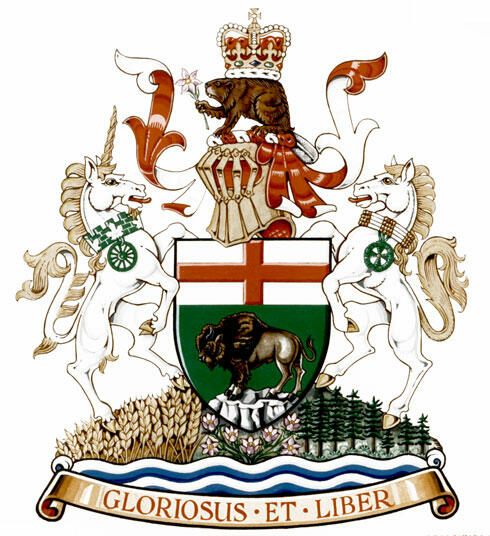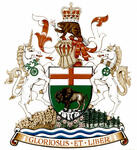The contents of this Register are intended for research purposes only. The heraldic emblems found in the Register may not be reproduced in any form or in any media without the written consent of the Canadian Heraldic Authority and/or the recipient.
Winnipeg, Manitoba
Registration of Arms
September 15, 2011
Vol. VI, p. 66
Arms of the Province of ManitobaBlazonVert on a rock a buffalo statant proper, on a chief Argent the Cross of St. George; SymbolismThe design is based on that of the great seal deputed for Manitoba, created by the Privy Council for Canada in 1870. The cross of St. George is the principal charge in the Arms of the Hudson’s Bay Company, which once exercised jurisdiction over present-day Manitoba. The buffalo represents the First Peoples, such as the Assiniboine and the Cree, who followed herds of buffalo on their seasonal migrations. |
CrestBlazonA beaver sejant upholding with its back a representation of the Royal Crown proper its dexter forepaw raised holding a prairie crocus (Anemone patens) slipped also proper; SymbolismThe beaver, a national symbol of Canada, represents the riches of Manitoba’s natural environment. It also symbolizes the fur trade, which was an important factor in the province’s early economic and social development. The Royal Crown on the beaver’s back symbolizes constitutional monarchy. The prairie crocus is the province’s floral emblem. |
MottoBlazonGLORIOSUS ET LIBER; SymbolismThis Latin phrase means “Glorious and free” and is taken from the Canadian national anthem. It evokes the democratic inheritance of Manitobans. |
SupportersBlazonOn a mound bearing seven prairie crocuses slipped proper between to the dexter a wheat field Or and to the sinister a forest of white spruce (Picea glauca) proper the whole rising above barry wavy Argent and Azure dexter a unicorn Argent armed crined and unguled Or gorged with a mural coronet Vert masoned and encircled with maple leaves Argent pendant therefrom the wheel of a Red River cart Vert sinister a horse Argent crined queued and unguled Or gorged with a collar of Prairie Indigenous beadwork proper pendant therefrom a cycle of life medallion Vert; SymbolismThe unicorn represents the province’s early Scottish settlers. Its collar symbolizes Manitoba’s position as Canada’s “keystone” province in the centre of the country. The collar further alludes to the stones of Fort Garry, a Hudson’s Bay Company fort during the fur trade period. The maple leaves are a symbol of Canada. The wheel of a Red River cart represents a distinctive form of transport in the province’s history. The horse was an animal vital to the First Peoples, the Métis and the European settlers. The collar of Prairie Indigenous beadwork and the cycle of life medallion represent the First Nations in the province. In the compartment, the water represents the rivers and lakes in the province as well as the origins of the province’s name, which comes from the name of the Cree spirit Manitou. The grain field represents the agricultural settlement that helped the province prosper in its infancy and is a symbol of the south of the province. The forest represents the white spruce, the provincial tree, as well as the north of the province. The prairie crocuses are the provincial flower of Manitoba. |
Additional InformationCreator(s)Original concept of the Privy Council of Canada, assisted by the heralds of the Canadian Heraldic Authority. PainterGordon Macpherson CalligrapherNot applicable Recipient TypeCivil Institution
Other InformationThe recipient's arms were originally granted by Royal Warrant of His late Majesty King Edward VII, dated May 10, 1905. The recipient's emblems were originally recorded in the Public Register of Arms, Flags and Badges of Canada, Volume II, page 2, 23 October 1992. |



